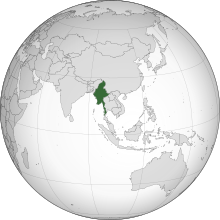Republic of the Union of Myanmar
| |
|---|---|
| Anthem: ကမ္ဘာမကျေ Kaba Ma Kyei “Till the End of the World“ 0:40 | |
| Capital | Naypyidaw[a] 19°45′N 96°6′E 19°45′N 96°6′E |
| Largest city | Yangon[b] |
| Official language | Burmese |
| Recognised regional languages | [citation needed] |
| Ethnic groups | |
| Religion | |
| Demonym(s) | Burmese[5] |
| Government | Unitary assembly-independent republic under a military junta |
| Myint Swe (acting) | |
• SAC Chairman and Prime Minister | Min Aung Hlaing |
| Soe Win | |
| Legislature | State Administration Council |
| Formation | |
| 23 December 849 | |
| 16 October 1510 | |
| 29 February 1752 | |
| 1 January 1886 | |
| 4 January 1948 | |
| 2 March 1962 | |
• Renamed from “Burma” to “Myanmar” | 18 June 1989 |
• Restoration of presidency | 30 March 2011 |
| 1 February 2021 | |
| Area | |
• Total | 261,227 sq mi (676,570 km2) (39th) |
• Water (%) | 3.06 |
| Population | |
• 2022 estimate | 57,526,449[6] (25th) |
• Density | 196.8/sq mi (76.0/km2) (125th) |
| GDP (PPP) | 2022 estimate |
• Total | |
• Per capita | |
| GDP (nominal) | 2022 estimate |
• Total | |
• Per capita | |
| Gini (2017) | medium |
| HDI (2021) | medium · 149th |
| Currency | Kyat (K) (MMK) |
| Time zone | UTC+06:30 (MMT) |
| Driving side | right |
| Calling code | +95 |
| ISO 3166 code | MM |
| Internet TLD | .mm |
Myanmar,[a] officially the Republic of the Union of Myanmar,[b] also known as Burma (the official name until 1989), is a country in Southeast Asia. It is the largest country by area in Mainland Southeast Asia, and has a population of about 54 million as of 2017.[10] Myanmar is bordered by Bangladesh and India to its northwest, China to its northeast, Laos and Thailand to its east and southeast, and the Andaman Sea and the Bay of Bengal to its south and southwest. The country’s capital city is Naypyidaw, and its largest city is Yangon (Rangoon).[2]
Early civilisations in the area included the Tibeto-Burman-speaking Pyu city-states in Upper Myanmar and the Mon kingdoms in Lower Myanmar.[11] In the 9th century, the Bamar people entered the upper Irrawaddy valley, and following the establishment of the Pagan Kingdom in the 1050s, the Burmese language, culture, and Theravada Buddhism slowly became dominant in the country. The Pagan Kingdom fell to Mongol invasions, and several warring states emerged. In the 16th century, reunified by the Taungoo dynasty, the country became the largest empire in the history of Southeast Asia for a short period.[12]
The early 19th-century Konbaung dynasty ruled over an area that included modern Myanmar and briefly controlled Manipur and Assam as well. The British East India Company seized control of the administration of Myanmar after three Anglo-Burmese Wars in the 19th century, and the country became a British colony. After a brief Japanese occupation, Myanmar was reconquered by the Allies and gained independence in 1948. Following a coup d’état in 1962, it became a military dictatorship under the Burma Socialist Programme Party.
For most of its independent years, the country has been engulfed in rampant ethnic strife and its myriad ethnic groups have been involved in one of the world’s longest-running ongoing civil wars. During this time, the United Nations and several other organisations have reported consistent and systemic human rights violations in the country.[13] In 2011, the military junta was officially dissolved following a 2010 general election, and a nominally civilian government was installed. This, along with the release of Aung San Suu Kyi and political prisoners and successful elections in 2015, improved the country’s human rights record and foreign relations and led to the easing of trade and other economic sanctions,[14] although the country’s treatment of its ethnic minorities, particularly in connection with the Rohingya conflict, continued to be condemned by international organizations and many nations.[15]
Following the 2020 Myanmar general election, in which Aung San Suu Kyi‘s party won a clear majority in both houses, the Burmese military (Tatmadaw) again seized power in a coup d’état.[16] The coup, which was widely condemned by the international community, led to continuous ongoing widespread protests in Myanmar and has been marked by violent political repression by the military.[17] The military also arrested Aung San Suu Kyi and charged her with crimes ranging from corruption to the violation of COVID-19 protocols, all of which have been labeled as “politically motivated” by independent observers, in order to remove her from public life.[18]
Myanmar is a member of the East Asia Summit, Non-Aligned Movement, ASEAN, and BIMSTEC, but it is not a member of the Commonwealth of Nations despite once being part of the British Empire. The country is very rich in natural resources, such as jade, gems, oil, natural gas, teak and other minerals, as well as also endowed with renewable energy, having the highest solar power potential compared to other countries of the Great Mekong Subregion. However, Myanmar has long suffered from instability, factional violence, corruption, poor infrastructure, as well as a long history of colonial exploitation with little regard to human development.[19] In 2013, its GDP (nominal) stood at US$56.7 billion and its GDP (PPP) at US$221.5 billion.[20] The income gap in Myanmar is among the widest in the world, as a large proportion of the economy is controlled by cronies of the military junta.[21] As of 2020, according to the Human Development Index, Myanmar ranks 147 out of 189 countries in terms of human development.[9] Since 2021, more than 600,000 people were displaced across Myanmar due to the surge in violence post-coup, with more than 3 million people in dire need of humanitarian assistance.[22]



